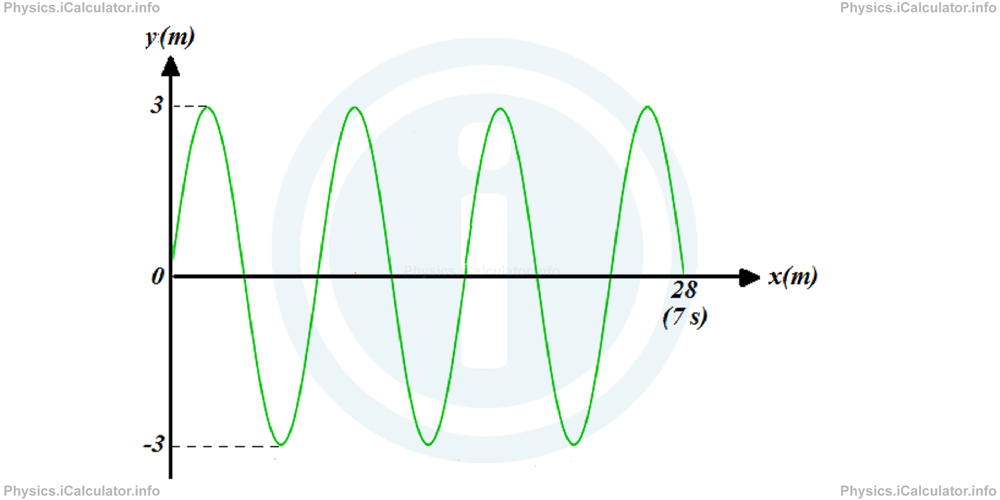Menu
Physics Lesson 11.1.4 - The Simplified Equation of Waves
Please provide a rating, it takes seconds and helps us to keep this resource free for all to use
Welcome to our Physics lesson on The Simplified Equation of Waves, this is the fourth lesson of our suite of physics lessons covering the topic of Types of Waves. The Simplified Equation of Waves, you can find links to the other lessons within this tutorial and access additional physics learning resources below this lesson.
The Simplified Equation of Waves
If waves travel through the same medium, they propagate at constant speed. Therefore, we can use the standard equation of uniform motion
to calculate the waves speed in a certain medium, where s is the distance travelled by the wave and t is the time of motion.
However, since waves move at the same speed throughout the entire process, often it is more appropriate to limit the study in a single cycle only. This eases the study of waves' motion as we can extend the outcome obtained in a single cycle in the entire process as well without the need for further data. We have discussed about a similar approach in circular motion, where we used circumference and period to calculate the speed of rotation instead of total distance and total time.
Thus, we can replace the distance s with wavelength λ (the distance travelled by the wave in one cycle) and the total time t with period T (the time needed to complete one cycle) in the equation of uniform motion. Hence, we obtain
for the speed of waves. Yet, to eliminate fractions in the formula, we can replacing period with its inverse, i.e. with frequency, as
Therefore, the above equation becomes
The last equation is known as the simplified equation of waves.
Obviously,
and
where N is the number of wave cycles during the entire motion.
Example 1
Look at the wave shown in the figure below.

Answer the following questions:
- What kind of wave is it?
- What is the amplitude of this wave?
- What is the maximum displacement a point of the wave can have?
- What is the wavelength?
- What is the period of this wave?
- What is its frequency?
- How fast does the wave move?
Solution 1
a) This is a transverse wave as the direction of particles oscillations (up-down) is perpendicular to the direction of wave's propagation (right).
b) Amplitude is the maximum displacement from equilibrium position to the highest point. From the figure we can see that the wave displaces 3 m (from y = 0 to y = +3 m) at maximum, so its amplitude is A = 3 m.
c) The maximum displacement a point of the wave can have is calculated from crest to trough, i.e. from the highest to the lowest position it can reach. Therefore, the maximum displacement is
= 3 m + 3 m
= 6 m
d) From the figure, it is easy to see that there are 3.5 cycles in total, (N = 3.5). During this process, the wave has travelled by s = 28 m. Therefore, wavelength is
= 28 m/3.5
= 8 m
e) Period is calculated in the same way as wavelength. Thus, since the total time t = 7 s and N = 3.5, we obtain
= 7 s/3.5
= 2 s
f) Frequency f is the inverse of period. Thus,
= 1/2 s
= 0.5 s-1
= 0.5 Hz
g) "Calculate how fast does the wave move" means, "calculate the wave's speed". Thus, using the equation of waves.
we find for the wave speed after substitutions,
= 4 m/s
You have reached the end of Physics lesson 11.1.4 The Simplified Equation of Waves. There are 4 lessons in this physics tutorial covering Types of Waves. The Simplified Equation of Waves, you can access all the lessons from this tutorial below.
More Types of Waves. The Simplified Equation of Waves Lessons and Learning Resources
Whats next?
Enjoy the "The Simplified Equation of Waves" physics lesson? People who liked the "Types of Waves. The Simplified Equation of Waves lesson found the following resources useful:
- Equation Feedback. Helps other - Leave a rating for this equation (see below)
- Waves Physics tutorial: Types of Waves. The Simplified Equation of Waves. Read the Types of Waves. The Simplified Equation of Waves physics tutorial and build your physics knowledge of Waves
- Waves Revision Notes: Types of Waves. The Simplified Equation of Waves. Print the notes so you can revise the key points covered in the physics tutorial for Types of Waves. The Simplified Equation of Waves
- Waves Practice Questions: Types of Waves. The Simplified Equation of Waves. Test and improve your knowledge of Types of Waves. The Simplified Equation of Waves with example questins and answers
- Check your calculations for Waves questions with our excellent Waves calculators which contain full equations and calculations clearly displayed line by line. See the Waves Calculators by iCalculator™ below.
- Continuing learning waves - read our next physics tutorial: General Equation of Waves
Help others Learning Physics just like you
Please provide a rating, it takes seconds and helps us to keep this resource free for all to use
We hope you found this Physics lesson "Types of Waves. The Simplified Equation of Waves" useful. If you did it would be great if you could spare the time to rate this physics lesson (simply click on the number of stars that match your assessment of this physics learning aide) and/or share on social media, this helps us identify popular tutorials and calculators and expand our free learning resources to support our users around the world have free access to expand their knowledge of physics and other disciplines.